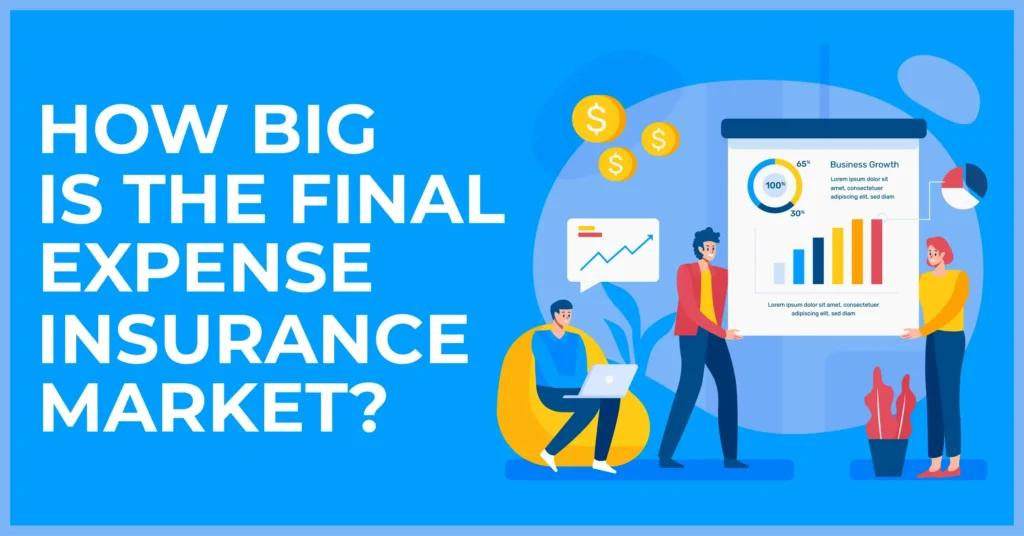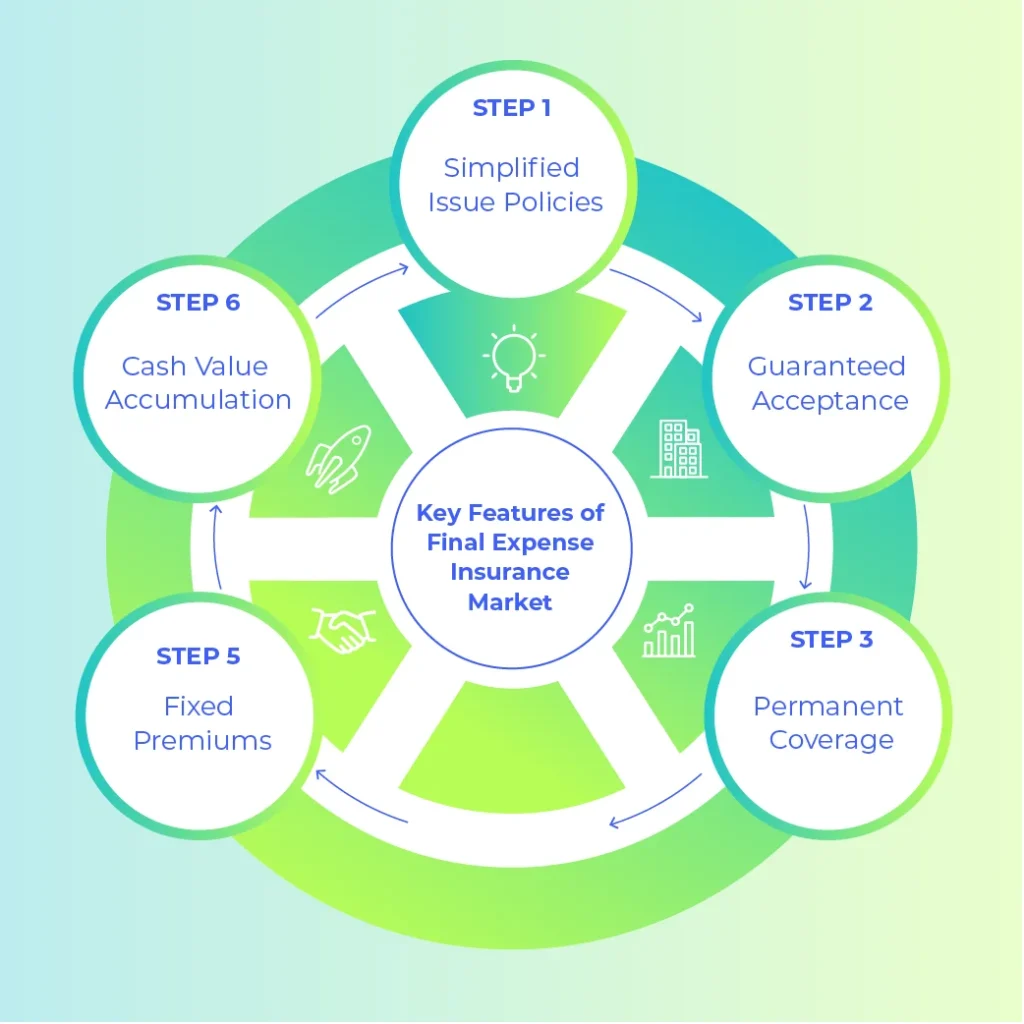
Do you know how big is the final expense insurance market?
The global final expense insurance market has experienced significant growth in recent years. In 2023, the market was valued at approximately USD 148.77 billion and is projected to reach USD 257.54 billion by 2030, growing at a compound annual growth rate (CAGR) of 7.10% during the forecast period from 2024 to 2030.
This expansion is driven by factors such as an aging population, rising funeral costs, and increased awareness of end-of-life expenses.
In this article, we will provide a comprehensive overview of the final expense insurance market, including its current size, projected growth, key trends, contributing factors, and the benefits it offers to individuals and families planning for end-of-life expenses.
Read More: How To Use Retargeting Ads For Final Expense Leads
Key Takeaways:
- The global final expense insurance market was valued at approximately USD 148.77 billion in 2023.
- Projected to reach USD 257.54 billion by 2030, with a CAGR of 7.10% from 2024 to 2030.
- Growth driven by an aging population, rising funeral costs, and increased awareness.
- Digital platforms and simplified underwriting processes enhance accessibility.
- Integration into financial planning provides peace of mind and financial security.
Table of Contents
What Is Final Expense Life Insurance?
Final expense insurance, sometimes known as “burial insurance or funeral insurance” is a type of life insurance policy designed to cover all the end-of-life expenses.
This insurance policy provides a death benefit to the chosen beneficiaries which can be used to cover various costs such as funeral arrangements, outstanding credit card debts, medical bills, and other expenses associated with the insured individual’s passing.
Benefits of Final Expense Insurance:
The following are the benefits of Final Expense Insurance:
- Financial Protection: Ensures that loved ones are not burdened with funeral and related expenses.
- Accessibility: Often does not require medical examinations, making it easier for individuals with health issues to obtain coverage.
- Fixed Premiums: Premiums remain constant over time, aiding in financial planning.
- Cash Value Accumulation: Some policies build cash value over time, which can be borrowed against if needed.
- Tax-Free Benefits: Death benefits are typically paid out tax-free to beneficiaries.
What Is The Final Expense Insurance Market?

The final expense market also called burial insurance or funeral insurance market is for people who want coverage for the funerals, burials, or other related expenses they may wish to pay at their end. This insurance is preferred by elderly people because it offers comparatively little income in case of the death of the insured person, which ranges between $5000 to $25000. These policies pay for expenses like funeral and burial fees, medical expenses, and any other liability so that the deceased has not left the family with such expenses.
Key Features of The Final Expense Insurance Market:

- Simplified Issue Policies: Minimal underwriting requirements, often without medical exams.
- Guaranteed Acceptance: Some policies offer guaranteed acceptance regardless of health status, though premiums may be higher.
- Permanent Coverage: Coverage lasts for the insured’s lifetime, provided premiums are paid.
- Fixed Premiums: Premium amounts remain consistent throughout the policy’s duration.
- Cash Value Accumulation: Policies may build cash value over time, accessible to the policyholder.
Market Size and Growth:
Estimates of the market size for final expense insurance vary, but several reports and studies provide a glimpse into its magnitude:
The global final expense insurance market was valued at approximately USD 148.77 billion in 2023 and is projected to reach USD 257.54 billion by 2030, growing at a CAGR of 7.10% during the forecast period from 2024 to 2030.
This growth is attributed to demographic shifts, increasing funeral costs, and heightened awareness of end-of-life financial planning.
Trends and Innovations:
The final expense market is witnessing several trends and innovations:
- Digital Platforms: Consumers are hence reaching insurers directly, getting online quotes, and processing forms that may have used to require a lot of paperwork.
- Customized Policies: It is on record that more organizations are adopting flexible policies for each category of people.
- Financial Planning Integration: Final expense insurance plans are seeping into comprehensive individual financial solutions, enabling people to better prepare for the last days’ costs.
- Partnerships with Funeral Homes: Some of the insurers are now working hand in hand with funeral homes where a policyholder can get the services under one roof hence compromising on the prices.
Factors Contributing To Market Expansion:
The expansion of the final expense insurance market is driven by several key factors, including demographic changes, economic conditions, and evolving consumer behavior.
Here are the primary factors contributing to the growth of this market:
- Aging Population: The global increase in the elderly population drives demand for final expense insurance as individuals seek to ensure their end-of-life expenses are covered.
- Rising Funeral Costs: The National Funeral Directors Association reported that the median cost of a funeral with viewing and burial was over $7,800 in 2021, highlighting the need for financial planning.
- Increased Awareness and Education: Educational campaigns by insurers and financial advisors have raised awareness about the benefits of final expense insurance.
- Simplified Underwriting Processes: Policies often do not require medical exams, making them accessible to individuals with pre-existing health conditions.
- Financial Security and Planning: Inclusion of final expense insurance in estate planning provides peace of mind and financial security for families.
- Economic Factors: Economic uncertainties prompt individuals to seek stable financial products with fixed premiums.
- Digital and Technological Advancements: Online platforms have streamlined the application and purchasing processes, making it more convenient for consumers.
- Government and Regulatory Support: Supportive regulatory environments and social security programs influence market dynamics.
- Cultural and Social Factors: Changing family structures and cultural practices impact the demand for final expense insurance.
- Competitive Market Landscape: Insurers are developing innovative products and expanding distribution channels to meet diverse consumer needs.
Conclusion – How Big Is The Final Expense Insurance Market :
The final expense insurance market plays a crucial role in providing financial security for end-of-life expenses. Driven by demographic changes, rising costs, and increased awareness, the market is poised for significant growth in the coming years. Individuals and families are increasingly recognizing the importance of planning for final expenses, making final expense insurance an integral part of comprehensive financial planning.
FAQ’s:
Is Final Expense Life Insurance Worth It?
Yes, final expense life insurance is valuable for individuals seeking to alleviate the financial burden on their loved ones by covering end-of-life expenses such as funeral costs, medical bills, and outstanding debts. It offers peace of mind and ensures that these costs are managed without impacting the family’s financial stability.
